Reactions Without Sense
Date added: 2023 April 10
Last modified: 2023 April 10
Table of Contents
Reactions Without Sense:
Asian American Reactions to the 2023 Shootings
Dedicated to the victims:
Yu Xiujuan, 57; Jian Hongying, 62; Li Lilan, 63; Yu Wen-Tau, 64; Nhan Mymy, 65; Ung Muoi Dai, 67; Valentino Marcos Alvero, 68; Diana Man Ling Tom, 70; Ma Ming Wei, 72; Kao Yu-Lun, 72; and Yau Chia Ling, 76.
Special thanks to my friends for editing and giving valuable feedback.
Content Warning: Death, guns, and description of the scenes of shooting.
Tragedy struck the 65% Asian community of Monterey Park on Lunar New Year’s eve, traditionally the day of a popular festival.1 That night, celebrating elders gathered inside a dance studio and continued the festivities. But around 10:30 PM, a shooting was reported there.2
One victim was killed outside. The gunman, according to the 911 calls released, had shot her through the window.3 He then entered the venue with a modified 9mm Mac-10, an unusual weapon for spree shooters. The Mac-10 suffers from jamming, but unfortunately, 42 bullets were fired unhindered that day.4
20 people were shot and 10 would die on the scene. Another would pass from the injuries sustained.5 The studio owner and many 60 and 70 year olds were among the dead.
After the carnage was over, the survivors of the ballroom took sight of the scene. There was blood collecting where the injured and dead lay.6 Many survivors cried. Others were in shock. They rushed outdoors and ran into emergency responders arriving.7
The shooter, however, was gone.
On WeChat, pictures posted were examined by Chinese news stations centered in LA. They released a description of the shooter: an elderly Asian man.
Twenty minutes later, at a dance studio in Alhambra, the same Mac-10 was pointed at a coder who had never seen a firearm in person before.8 He fought and disarmed the shooter, preventing what would have been another tragedy.9
The shooter then escaped in a white van. He was at large for most of the morning, but would seek medical treatment in the opposite corner of LA. He left the hospital before they treated him.

Found in Torrance the next morning, tracked by his gun and a tip from that hospital,10 a standoff began before he took his own life.11
The day after would be another shooting, this time in Half Moon Bay, with many Asian American victims as well.
Through sheer loss of life and timing, these shootings have become a traumatic memory within the Asian American community. Though tragic, these events provided an opportunity to observe the community’s reaction and beliefs, and thereby detect latent community issues. What I hope to provide here is an understanding of these reactions and what prompted them. Perhaps, with the reactions understood, we can prevent another tragedy.
The White Reaction
I wanted to avoid this, but in a racialized country, race finds a way. While these shootings shouldn’t be racialized, the barrage of responses by white people were enough to warrant discussion.
Asians provide a specific function to America: they are a useful wedge towards Black people. This is known as racial triangulation.12
It is a common excuse among white people that if Asians can “succeed” then Black people can too. Asians are the model minority, while Black people are just not trying hard enough. There’s two flaws to this narrative: success is not just economic; it is social, and this explanation ignores history.
When Asians (mostly male Chinese laborers) started arriving en masse in the 1800s because of the Gold Rush (and other factors), they faced systemic discrimination in jobs and housing, and they faced xenophobic hate. For example, lynchings of Chinese were common. The LA Chinese massacre of 1871 is the largest lynching in this country’s history.
Before the 1960s, Asian exclusion laws also forbade Asian women from entering the country until Asians and Black people struggling in the Civil Rights Era undid that policy. Prior to the 1960s, Asians were also stereotyped as drug users or gangsters trafficking opium and women. It was only the recent immigration waves that brought people with advanced degrees which created the model minority myth.
But by its name, it’s a myth. It takes statistical trickery to produce the model minority myth: specifically conflating Asian ethnicities together and ignoring the specific situations of Hmong, Cambodian, Laotian, Nepalese, third or fourth generation Asians, and so on.
Further, Black Americans did “succeed” during Reconstruction, if we define success politically and economically. In that era, many Black people obtained economic wealth and political enfranchisement. But the Civil War didn’t end. Just as any war is followed by resistance, the KKK and other white supremacist groups continued the fight, meeting no resistance since the coalition of abolitionists and industrialists in the north had broken. The white industrialists tacitly allowed hate groups to proliferate so the north could pursue economic profit, leading to Jim Crow laws and institutionalized sharecropping that sabotaged the economic success of Black people. And when Black people succeeded in spite of those systemic barriers as in Tulsa, Oklahoma, white people burned their “success” in retaliation.13
I bring up racial triangulation and Reconstruction history for their relevance in understanding this response. Racial triangulation describes Asians’ condition in this country accurately. Asian Americans suffer in social prestige and are considered foreign relative to Black and white people. However, Asians and whites are considered ‘superior’ to Black people socially. Thus Asians are ‘triangulated’ against Black and white people. From this division, Asians’ economic success in this country is utilized as a wedge issue to control all minorities, stopping any legislative progress.

That is the key idea, Asians are used as weapons by white people when needed. The white reactions to these two shootings reveal this idea. Upon revealing the shooter’s race, the gloating was unending. Here are a few examples:


From Instagram, the account @goldhouseco provides an Asian focused perspective and is a space that is mostly engaged with by Asians:

The top comments are from Asian celebrities. Other comments were confirmed to be Asian by their profile pictures. However, past a few scrolls, there were comments by white people (again through their profile pictures) saying things like:
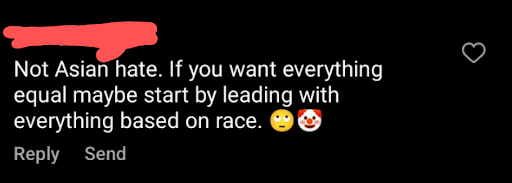
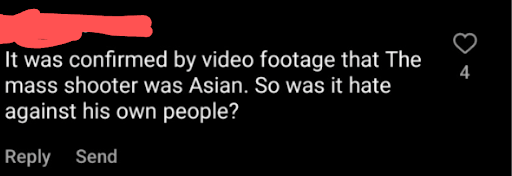
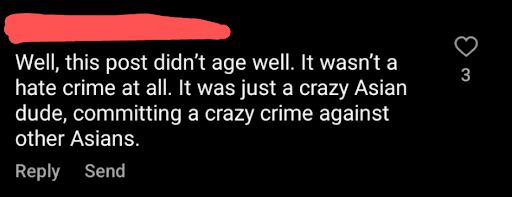
It was only white people (and a few Asians) who expressed these sentiments.
On Twitter several Asian celebrities even noted the glee with which white people had when reminding these celebrities the shooter was Asian:
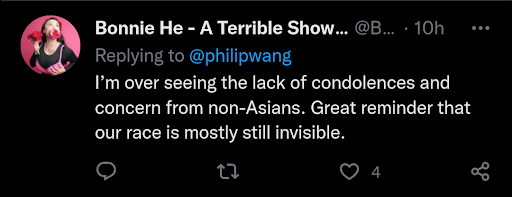
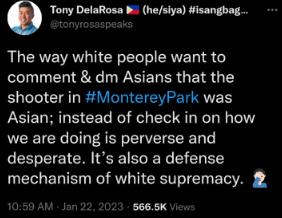
Another Asian commented on Tony’s tweet, noting this interaction in their dms:
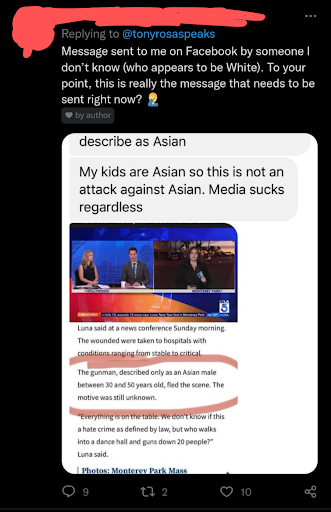
After Tony’s post, the vast majority of responses were defensive, and from the ones I could identify as white they were angry:
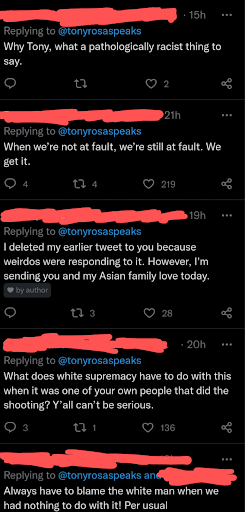
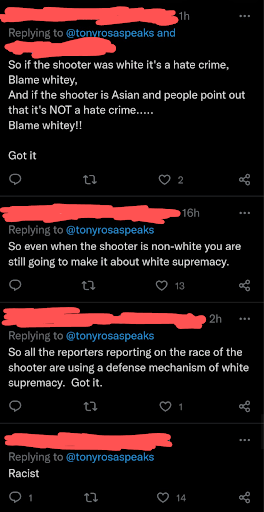
A week later, there were still comments on Instagram hammering in the shooter’s race.
The defensiveness and the desire to remind Asians of the shooter’s race was evidently to redirect attention away from the stereotype of white shooters, as demonstrated by Twitter. That there were white people who were ready to use Asian tragedy for their benefit supports racial triangulation theory.
However the theory is not flawless. It removes agency from Asian Americans, who played a part in constructing their position above Black people in the country.14 Those who have come over in recent diaspora waves have absorbed western influences including racism, and the history of nationalism movements of the late 19th and 20th centuries have often involved eugenics that have an effect on Asian-Black relations today.15
Ideological racism, premised on convincing “the poorest white that they’re better than the best Black people” in order to stop change, was also attractive to Asians. Reconstruction’s failure was partly because ideological racism convinced the poor whites of the south, despite their own economic exploitation by the rich elite, to ally against Black people.16 Given the background of recent Asian immigrants and those of the 1800s, the desire to avoid being “Black” provided a “mental wage” to many Asians.
But Asians did not merely take advantage of their position with Black people. Asians were involved in the Civil Rights movement. Yuri Kochiyama was by the side of Malcolm X when he was assassinated. The Black Panthers and Asian Americans provided mutual support to each other, and there were many Asian members. For every story of bad blood, there is one of mutual aid and help. Communities are, after all, complex and multifaceted. New research uncovers buried narratives, like those surrounding the LA Race Riots, all the time.17
I also want to emphasize the obvious: not all white people did this. Twitter, a platform thriving on algorithmically manufactured outrage is not representative. Reddit provides a better observation for what white people do since accounts are automatically subscribed to r/news and the vast majority on the site are white people who only upvote or downvote. On the posts those few white commenters had to chime in on, the vast majority of people upvoted the top level supportive comments, which illustrates very clearly that the majority of white people are not as racist as those in the comments.
That there were such strong responses, however, indicates racism is involved in any event in this country. Shortly after the hospitalization of the victims, someone who was not the shooter threatened to “finish the job” in a call.18 Though the caller is unknown, we see that this event was racialized, and racists would seize an opportunity to gloat upon 11 people’s deaths rather than mourn.
Unfortunately there are also Asians who ally with the racists. Many older Asians supported Trump in 2016, and some Asian women are married to Neo-Nazis and right-wingers. There were also Chinese and Vietnamese people at the Capitol Riots, and there were some Asians who were quick to remind others the shooter was Asian, rather than mourn or say anything more constructive.
After Half Moon Bay, moderate white people began using tropes of Asian xenophobia. Two elderly Asian shooters was enough for them to wildly speculate conspiracies. They left behind logic and ran headfirst into Communist Chinese Party (CCP) conspiracy:

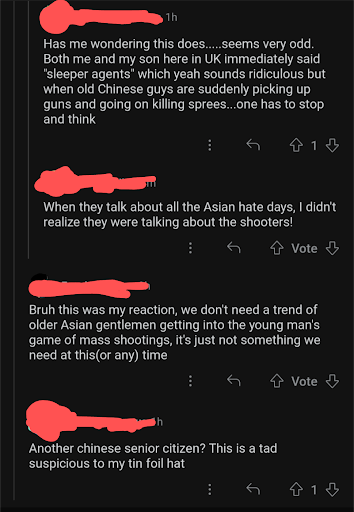
or Falun Gong conspiracy:
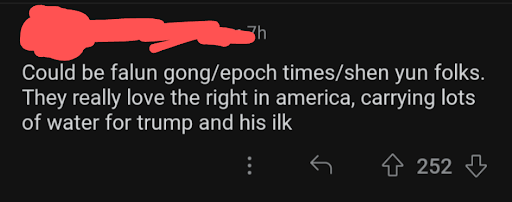
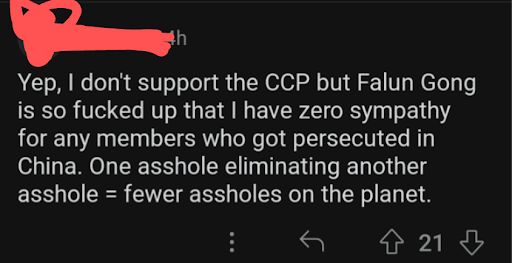

These racist responses were highly voted.
The CCP sympathizers’ conspiracy relies on old xenophobic tropes of imperial Chinese and Communist secret police, not to forget other classics like the red scare, perpetual foreignness, etc. The Falun Gong conspiracy however taps into older racist historical stereotypes. When Chinese Americans were segregated and prevented from working, and immigration laws prohibited women from entering the country, leaving those men unable to start families, Chinese Americans formed gangs.
Gangs are not just criminals organizations. They are better thought of as businesses using illegitimate means to seek profit, and they also provide community aid and a sense of honor and purpose. Without legitimate economic opportunities, gangs form to avoid abject poverty. Similar processes are responsible for ethnic gang formation across the US. In Fresno, this process fuels Southeast Asian gang activity.
Chinese Tongs formed because prostitution, drugs, and gambling were the only way to obtain material wealth for Chinese people, and it was these organizations that spawned these stereotypes. But originally they were food sharing houses, before operating costs forced them into illegal activities, and the sexual trafficking they started might have been reduced had there not been a gender imbalance stemming from aforementioned immigration laws barring Asian women from entering.
Organized crime created secrecy, and secrecy created suspicion, combining with perpetual foreignness to create the trope of the crafty and calculating Asian, always willing to bring down ‘civilization’ for their foreign country’s benefit. MSG discrimination of Asian restaurants and hate crimes stems from this form of racism.
That even moderate white people reacted this way following Half Moon Bay should be a reminder that racism is always present in America, latent but waiting to leap out at a moment’s notice.
Asian Reactions
There were three general reactions: mourning, unsurprise, and shock.
With all tragedies, mourning is expected, but this case is unique for Asians. In most other incidents of Asian American homicide, the perpetrator is often alive, and once in court, death penalty charges are sought. Monterey Park is an exception to that rule.
Beyond mourning, there was unsurprise. Those who reacted this way were matter-of-fact, or implied this was ordinary. It was peculiar as a response but prevalent among some Asian men.
Lastly, there was shock. This is not an uncommon reaction, but it struck a communally felt pain upon Asian Americans in a way events hadn’t before.
Mourning
The majority of responses were this, from celebrities to commenters.
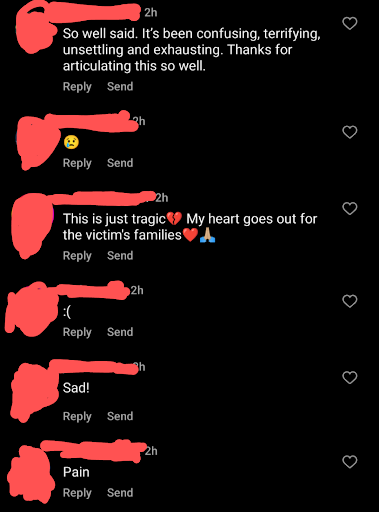
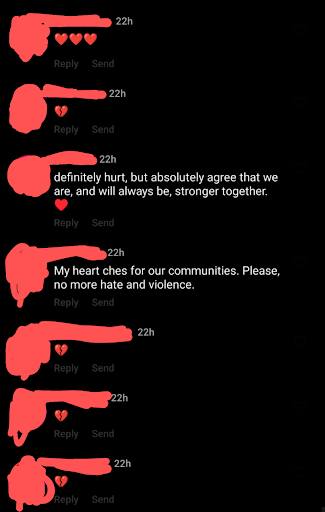
There were usually posts linking to GoFundMe’s for the victims, offering their own brief opinions of the issue. Many expressed anguish.
As stated before, the Monterey Park shooting is exceptional in two ways. The first way is timing: it occurred on Lunar New Year. However there is a second and equally important way this is different: the shooter committed suicide.
In most public crimes befalling Asian Americans, the perpetrator lived. In the Atlanta Spa Shootings, the death penalty was pursued within two months of the event.19 In other cases, such as with the killing of Michelle Go, trial was held and the perpetrator was locked away in a mental health facility after they turned themselves in.
Asian Americans conceive of justice as punishment, eye for an eye. It slots in with many traditional Asian law systems, and the desire for a proper ‘degree’ of vengeance is certainly present in Asian Americans. One need only look at the reaction towards the killing of Vincent Chin. There is also rage that comes with sudden grief, no doubt felt in the victims of this many other shootings, that punitive justice seems perfectly fit to satisfy.
But this shooting-suicide shows the limits to that form of justice. This desire to punish, to cause pain upon the other, while natural, is not sensible. The result, death, would be the same. The only difference is the hand that dealt it. Had the shooter lived, he would have been subject to the death penalty. Perhaps execution would have given closure to the victims, but for those who desired blood, his execution would have been nonsensical. He dies either way. Paradoxically, if he lived, he would more likely be sentenced to prison for life. But the justice system can at most give a symbolic 11 life sentences. So perhaps torture, as the US can and does do via solitary confinement, is the last option which is both morally reprehensible and not enough to capture the loss of 11 lives.
The Monterey Park shooting is not addressable by our system of punitive justice.20 Suicide shootings, while conducted by a perpetrator, are natural disasters in a country saturated with firearms, it just so happens that these natural disasters are illegal. There is no punishment, only unsatisfiable mourning.
Unsurprise
While the majority mourned, there was a certain minority of Asians (largely men) who reacted strangely after finding out the race of the shooter. Confronted with any tragedy, a response from anyone would be expected, but for these people their reaction was closer to a shrug.
For example, before any information was confirmed, this group had decided very proudly that the shooting was gang violence. This may seem plausible, but this ignores what gangs are: businesses. Therefore gangs do not typically pursue public mass shootings. Gangs must stay away from police to function, and while there are honor killings and drive-bys, they are discreet in order to avoid police attention or tracking.
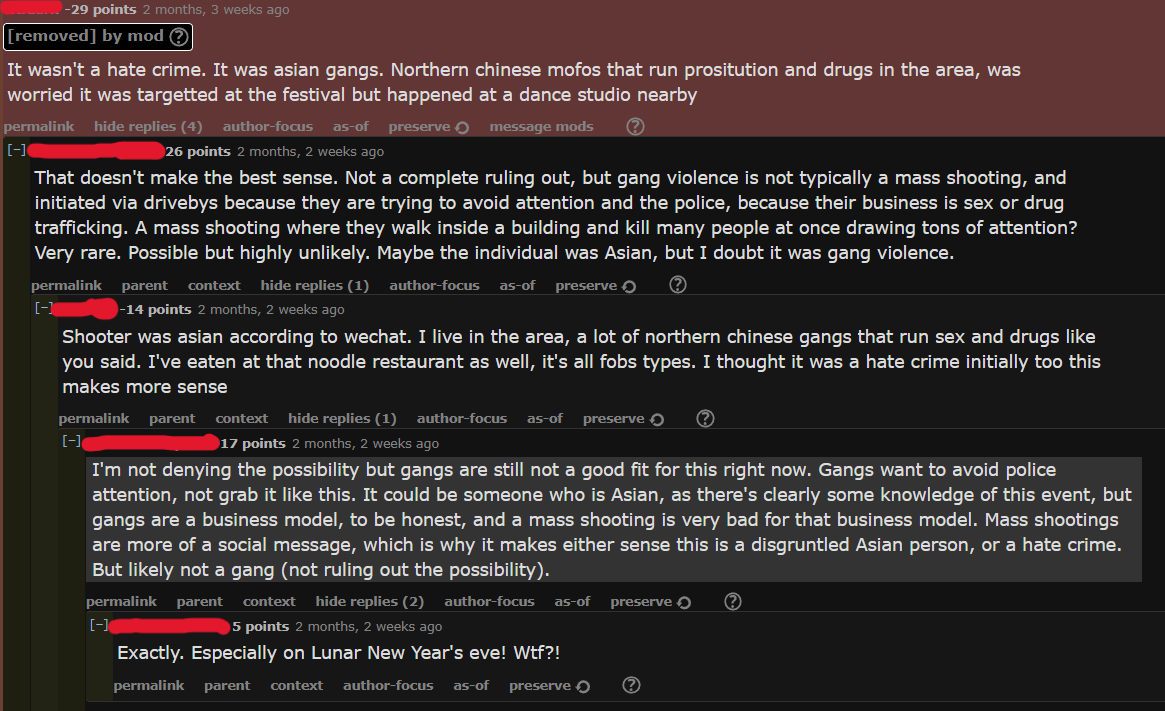

Pushed to elaborate, they gave fumbling responses. They would come up with untested theories, and assume that it must have been some sort of ‘criminal type’ who did this. Furthermore, their responses were matter-of-fact. They were emotionless, unfeeling, possibly uncaring. The need to fit the shooting into their category of gang violence seems to be a method to shrug off the seriousness of the tragedy. If it is gang violence, there is no need to be so alarmed: it’s “just” crime. It’s not that their grandfather can be a shooter, it’s only “gang violence.” Since there has always been crime or gang violence, there’s no way to do anything about this shooting, so why worry?
The next day their responses were deleted.
There was another group that had a similar response as well upon discovering the race of the shooter. These were Asians who also went into comment sections to boldly proclaim the shooter’s race, and had nothing else to say besides that. These were a minority as well, and almost entirely men, but they were similar to the gang response. It’s just “Asian-on-Asian” crime, the implication being since intra-community crime always happens, there’s nothing to be done. It’s just a freak incident.
Like those committed to the gang theory of violence, these people also could not elaborate beyond the apparent race of the shooter. They didn’t seem to mourn. They didn’t seem to think about issues that might have led here. They didn’t seem to care about the tragedy. In fact they were most vocal on mourning posts, as if to say, “don’t mourn, it doesn’t matter.”
Shock
The final reaction was shock. This reaction could manifest in several permutations. For example, it could be expressed as rage:

But there was also cognitive dissonance described in articles by The Atlantic.21 In a Huffington Post article, the shooting was described as having shattered, “the notion that we could feel safe from shootings within our own AAPI enclaves.”22 An article on Elle makes similar claims.23 This reaction also transcended age. Amongst many of the Monterey Park survivors, they bemoaned the loss of safety within the enclave.24
These shootings, beyond being a tragedy, seemed to have assaulted the belief of a safe Asian enclave, the belief that merely being Asian is safe.
It is not ethnic makeup that makes a place like Monterey Park safe, it’s because it’s a suburb. Historically, minority enclaves were crime filled. Though Chinatowns were safer from wider society (i.e. protection against lynchings) they fell into the pattern. To this day, many old Chinatowns and ethnic enclaves still maintain a reputation for crime. If you are ever in a Chinatown, and you see 堂 (táng) written on top of a building, that used to be or is a gang house.
No ethnic enclave really brings safety. The Hood or the Ghetto is not associated with safety. The only safety of places like Monterey Park comes from wealth.
The New York Times published an op-ed by Jeff Yang, father to Hudson Yang (who starred in Fresh Off the Boat), who claimed these recent shootings are a sign of assimilation.25 This article, while with its merits, has some issues. It benefits from identifying the Laguna Church shooting with these recent ones, but commits the ecological fallacy: it moves from the claim that Asian Americans have purchased guns recently (a macro level phenomenon) to the claim that the shooters purchased guns recently (a micro level phenomenon). As of right now, the Half Moon Bay shooter’s weapons were confirmed to have been bought recently, but the time of acquisition for Monterey Park is unknown since the weapon used was unregistered. That weapon was also banned in California, making it possibly illegally acquired or purchased before assault weapon laws were in place.
As a useful supplement, the Elle article brings up many sociological issues, but doesn’t fairly connect them to this incident,26 though the concept of Unassimilability, that within ethnic enclaves like Monterey Park they avoid assimilation, is brought up.
What helps these two articles is sociohistorical context. They contextualize these shootings and trace out their patterns. These shooters, for example, are exceptional in their age.27 Yang’s article does a good job of arguing why that might be. The Elle article is more useful for understanding the reactions to these events, and making sense of them. And both bring up assimilation (and unassimilation) as ideas.
But focusing exclusively on assimilation without including the influence of ethnocentrism is also a limitation of their analysis. Additionally, assimilation and unassimilation are false dichotomies presented as if it’s either-or, you are assimilated or you aren’t.
But that is not true, assimilation is already here. Asian immigrants grew up in countries where western influence had already touched them.
Why These Reactions?
Mass shooters are not overrepresented white. In fact mass shootings match the demographics of the U.S. remarkably well.28 Asian mass shooters don’t lack fame either. The Virginia Tech shooter, Seung-Hui Cho, killed 32 in his mass shooting.
As Jeff Yang notes, there were signs of an impending shooting. Asians were buying guns due to COVID hate crimes,29 and the demographics of these recent shootings were alluded to before, in Laguna Church. While at the time Laguna seemed like a one-off incident, in hindsight it was not. It was an early signal of social issues within Asian communities that have been building.
There have been calls for expanded mental health services and further restrictions on guns,30 all good things and necessary. But there are more issues than mental health that afflict our elderly, namely loneliness, poverty, and ageism among many other problems that I will discuss another time. There are also issues the elderly inflict upon the community: misogyny, patriarchy, displaced trauma, etc. Mental health services may assist and alleviate some issues, and curtailing gun ownership may prevent further tragedy, but the root causes of these tragedies may not be solved by these solutions, and we should not let the elders we speak so highly of pass away without a better quality of life.31
All this is to say that assimilation is not the only factor. Ethnocentrism must be considered. Ethnocentrism has been brought over from historical homelands, where nationalism has reigned supreme since the twentieth century. And though we speak of assimilation as if it is a destination Asian Americans can be at, this ignores the history of imperialism. Southeast Asians were already influenced by French and Dutch culture before arriving here. The Philippines had been influenced by Spain and the US. Japan and China, while not imperialized the same way as other places, had absorbed Western ideas such as eugenics, race theory, socialism, capitalism, nationalism, and imperialist ideologies in their struggles to modernity.32
Assimilation has been there before arrival into the U.S. Yes, culturally, many Asians aren’t completely assimilated, but there’s more than just cultural assimilation. There can be social assimilation (connections to populations within the mainstream) and material assimilation (owning what the dominant group owns in a country). These dimensions aren’t distinct from each other, they’re all connected and related. Material assimilation will to some degree influence one’s assimilation in the other categories too, and vice versa.
Ownership of guns, a form of material assimilation, influenced these shootings, even though Asians maintain their distance from the cultural mainstream, and ethnocentrism has lulled us into false security. If you have a gun, you’ll still use it as a gun. From The Odyssey, “The blade itself incites to deeds of violence.” It doesn’t matter who you are, there’s no exceptional race.
Mourning, the absence of anything but punitive justice to deliver solace to grieving victims, results from Asian justice systems slotting in with America’s justice system.
Unsurprise, it manifests in two ways depending on ethnocentrism and assimilation. In the first reaction, the need to declare the shooter a ‘criminal’ is a nationalist knee-jerk to avoid mental dissonance, marking those in the community who commit crimes as monsters rather than the result of problems within. In the second reaction, ignoring these shootings’ importance as a problem results from a high degree of cultural assimilation absorbing ideas such as racist rhetoric.
And shock, the destruction of a myth of safe Asian enclaves stems from both material assimilation and ethnocentrism—wealth allowing Asians to ignore their implicit benefits, and ethnocentrism wrongly attributing safety to race or ethnicity.
This is a long way to say there needs to be greater awareness of our sociohistorical context and examination of our community’s problems. Until that happens, there will only be more incidents like these.
Methodology and Limitations
I collected a large dataset of messages from social media sites. That comes with many limitations. Effectively this is an observational study. It can do nothing but show that certain beliefs or opinions exist. With some difficult reasoning, one may be able to tease out relative proportions of responses.
But unbiased sampling is hard. While the opinions that were expressed here I believe to be representative of a large swath of Asian Americans, many more expressed no opinions. Under anonymity, these were ‘lurkers,’ those who only give upvotes on Reddit and who only like on Twitter and Instagram.
We might be able to gauge how popular certain opinions are to social media users, but generalizing them to anything but white America is hard, if not impossible this way. On social media sites, the vast majority of users are white. Lurkers and likers are more representative of that population than any other.
Furthermore, we have an age bias here. Most users are not your grandparents. It’s hard to figure out what their opinion is, the only way to do that would be to go knocking on elderly Asian households and interviewing them to collect statistics. They may not even have opinions, especially if they haven’t heard about the shootings.
I don’t think that limits this observational study. The purpose was to ascertain current opinions and why they exist. It is possible that elderly Asians may have strong feelings in this, but in my personal experience, they are exhausted from poverty, war, and age, and would much rather rest their thoughts. It falls upon those who have grown up in this country to take action, which is why I take these opinions seriously; they are indicators for future community health.
Another issue, perhaps a greater one, is that the opinions expressed are biased towards Asian men. The subreddits for Asians are mostly Asian male dominated, but while I tried to monitor opinions from female Asian subreddits, there were basically none. This is not to say there’s truly no response, or that Asian women are disinterested. Men in general often take more interest in these issues on social media. Women by contrast take action on the ground, much more than men. Vincent Chin’s movement had several prominent women leading it, including his mother. Much of the Atlanta and community watch organizations were due to Asian women organizing too. I gather there’s likely two processes: Asian women choose action over talk, or they don’t act at all. Disinterest is not unreasonable either: shootings correlate highly with domestic abuse. To suggest to Asian women suffering from such abuse to fix it, when it is in large part a problem of masculinity would be unreasonable. The abused should not take the lion’s burden of fixing abuse. That should fall upon the abusers and others who are more willing and able to do so.
I monitored Reddit News threads as well as two Asian subreddits, mostly male dominated. Reddit News provided a decent control as there were more white users on there. AsianMasculinity is an Asian subreddit of more moderate-to-right leaning Asian men. I also trawled the dregs of AznIdentity, a Pan-Asian ethnocentric, right-leaning male dominated subreddit. This is of course, unreasonable to generalize upon, but it gives a large spectrum of reactions to analyze.
Outside of reddit, I focused more on Instagram due to there being several prominent Asian news pages. I could be confident, based on inspections of the users and their profile pictures, of Asian participation and commentary. It was here that I was able to balance out the male heavy reactions with more feminine ones, though these were mostly of mourning. However, I don’t think that indicates any less interest, so much as a lack of interest in virtue signaling.
I also used a few celebrity stories and threads on Instagram and Twitter. On Twitter, the reaction was more white than Asian, while on Instagram, it was more Asian than white. It was yet another way of obtaining a control. These threads also presented more moderate to left leaning opinions.
Post Script
After the Monterey Park shooting, the Pechanga Band of Indians donated $100,000 to the funds of for victims’ families.33 Such a large sum is a strong sign of genuine friendship between Asians in Monterey Park and the Pechanga Indians, who said: “the city and community of Monterey Park opened its arms to Pechanga more than a decade ago to partake and contribute to the excitement of its Lunar New Year Festival. As we mourn the victims of Saturday night’s tragedy, Pechanga’s commitment to the community remains unwavering.”
It’s important to recognize this friendship, since it runs counter in many ways to Asian Americans and indigenous relations. Since the experience of Native peoples in these lands has been that of forced removal, betrayal, and outright genocide, with the intent to move in settlers upon their lands, Asian Americans, an immigrant people have participated in their form of oppression. There have been less than harmonious relations with Native Hawai’ians and Asians for example.
In the face of such historical ill will, that friendship between Asians and American Indians can find space to grow is a testament to changing times and the possibility of a cooperative relationship in the future, one that is not harmful to Native American or Pacific Islander peoples, but mutual.
Resources
Sources About Elderly Asian Issues
Sources for Sociohistorical Context
A cursory course in Asian American history is good, but I would argue not enough. I do understand that people have lives and can’t dedicate their time to these things. However, an understanding of these problems and their solutions come with extended reading. There’s a lot of popularly recommended readings that I see the flaws in, so here is a (very) short shortlist of material I enjoyed or have heard is decent. It is biased towards Chinese Americans as that is what I know primarily (and because problems from or directed towards Chinese Americans disproportionately affect the rest of Asian America). They are not in any order.
- The Making of Asian America: A History - Erika Lee
- The Chinese Question: The Gold Rushes and Global Politics - Mae Ngai
- The Chinese Experience in America - Shih-Shan Henry Tsai
- Racial Formation in the United States - Michael Omi, Howard Winant
- Orientalism - Edward Said
- Hatchet Men: The Story of the Tong Wars in San Francisco’s Chinatown - Richard H. Dillon
- Getting Saved in America: Taiwanese Immigration and Religious Experience - Carolyn Chen
- The Shifting Grounds of Race - Scott Kurashige
- Blue Dreams: Korean Americans and the Los Angeles Riots - Nancy Abelmann, John Lie
- The Racial Triangulation of Asian Americans - Claire Jean Kim
- Empire of Care: Nursing and Migration in Filipino American History - Catherine Ceniza Choy
- Asian American Panethnicity: Bridging Institutions and Identities - Yan Le Espiritu
-
From here: “Past Lunar New Year events in Monterey Park have drawn crowds estimated at over 100,000 visitors per day from all over the Southern California area” ↩︎
-
From New York Times ↩︎
-
From New York Times ↩︎
-
From CNN: “Shortly after the attack, authorities say the gunman showed up at a second studio in nearby Alhambra, where a group of people confronted and disarmed him.” ↩︎
-
From CNN - “Police received a tip Sunday from an area hospital where a man fitting the description of the suspect came into the emergency room seeking treatment for injuries consistent with having been in a fight. The man waited for a period of time and then left the hospital without receiving treatment. The hospital notified authorities when they saw the similarity to the wanted person depicted in photos on the sheriff’s department’s Twitter account. ↩︎
-
Look up the Tulsa Race Massacre, and the Greenwood District, which was known as “Black Wall Street.” ↩︎
-
See In re Ah Yup, a landmark case in which the plaintiff argued in 1878 that Asians were white. It was not accepted, with the declaration that ‘Mongoloids’ are not ‘white.’ ↩︎
-
For example, Kang Youwei, a socialist harbinger who influenced the later revolutionaries in China, promoted a program of eugenics, and his book is still popular in the country. ↩︎
-
I would recommend the classic Black Reconstruction in America, the magnum opus of W.E.B. Dubois, one of the founders of sociology. This book spawned the revisionist perspective on the Reconstruction era that is now dominant. That racism provides a mental wage to the non-Black of this country is well accepted theory. ↩︎
-
The book to read is Blue Dreams: Korean Americans and the Los Angeles Riots. The opinions by Koreans towards the race riots was extraordinarily diverse, and it was overlooked due to politicization and because news reporters could not speak Korean. ↩︎
-
A more elaborate critique of punitive justice would take a long time, but that punishment is first and foremost in the system is the biggest problem. There’s no room for other methods that could be more appropriate, and the effect is disproportionate amongst minorities. ↩︎
-
ibid Elle ↩︎
-
Source. Asians are probably almost as ageist as non-Asians. ↩︎
-
Look up Kang Youwei once again ↩︎
